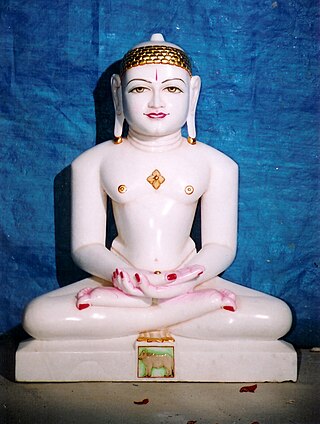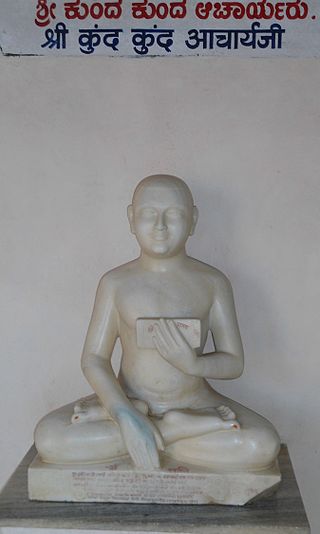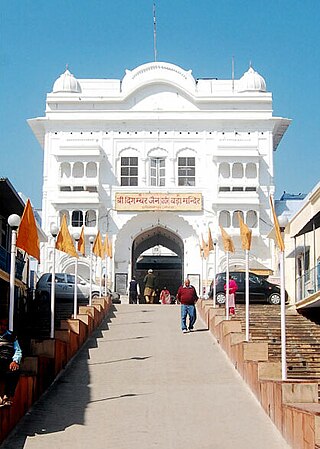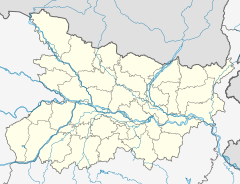
Mahavira, also known as Vardhamana, was the 24th Tirthankara of Jainism. He was the spiritual successor of the 23rd Tirthankara Parshvanatha. Mahavira was born in the early 6th century BCE into a royal Jain family of ancient India. His mother's name was Trishala and his father's name was Siddhartha. They were lay devotees of Parshvanatha. Mahavira abandoned all worldly possessions at the age of about 30 and left home in pursuit of spiritual awakening, becoming an ascetic. Mahavira practiced intense meditation and severe austerities for twelve and a half years, after which he attained Kevala Jnana (omniscience). He preached for 30 years and attained moksha (liberation) in the 6th century BCE, although the year varies by sect.

The Śvetāmbara is one of the two main branches of Jainism, the other being the Digambara. Śvetāmbara in Sanskrit means "white-clad", and refers to its ascetics' practice of wearing white clothes, which sets it apart from the Digambara or "sky-clad" Jains whose ascetic practitioners go nude. Śvetāmbaras do not believe that ascetics must practice nudity.

Parshvanatha, or Pārśva and Pārasanātha, was the 23rd of 24 Tirthankaras of Jainism. He gained the title of Kalīkālkalpataru.

In Jainism, a tīrtha is used to refer both to pilgrimage sites as well as to the four sections of the sangha. A tirtha provides the inspiration to enable one to cross over from worldly engagement to the side of moksha.

Buddhism and Jainism are two Dharmic religions that developed in Magadha (Bihar) and continue to thrive in the modern age. Gautama Buddha and Mahavira are generally accepted as contemporaries. Jainism and Buddhism share many features, terminology and ethical principles, but emphasize them differently. Both are śramaṇa ascetic traditions that believe it is possible to attain liberation from the cycle of rebirths and deaths (samsara) through spiritual and ethical disciplines. They differ in some core doctrines such as those on asceticism, Middle Way versus Anekantavada, and self versus non-self.

Mangi-Tungi is a prominent twin-pinnacled peak with plateau in between, located near Tahrabad about 125 km from Nashik, Maharashtra, India. Mangi, 4,343 ft (1,324 m) high above sea level, is the western pinnacle and Tungi, 4,366 ft (1,331 m) high, the eastern. Mangi-Tungi is 30 km (19 mi) from the city of Satana.

Vasupujya is the twelfth tirthankara in Jainism of the avasarpini. According to Jain beliefs, he became a siddha, a liberated soul which has destroyed all of its karma. Vasupujya was born to King Vasupujya and Queen Jaya Devi at Champapuri in the Ikshvaku dynasty. His birth date was the fourteenth day of the Falgun Krishna month of the Indian calendar. He never married and remained a celibate. He attained Kevala Jnana within one month of Tapsya and Moksha at Champapuri, of Bihar in India on the fourteenth day of the bright half of the month of Ashadh.

Jain symbols are symbols based on the Jain philosophy.

Bhagalpur, historically known as Champa Nagri, is a city in the Indian state of Bihar, situated on the southern bank of the Ganges river. It is the third largest city of Bihar by population and also serves the headquarters of Bhagalpur district, Bhagalpur division & Eastern Range. It is known as the Silk City & also listed for development under the Smart Cities Mission by Government of India. It is the only district in Bihar after capital city Patna where three major higher educational institutions IIIT, TMBU & Agriculture University(BAU) are located and also Vikramshila Central University is under construction next to the ruins of ancient Vikramshila University. Bhagalpur Railway Station serves the city. The river around city is home to the Gangetic dolphin, the National Aquatic Animal of India, and the Vikramshila Gangetic Dolphin Sanctuary is established near the town. The city holds the largest Manasa Puja and one of the largest processions in Kali Puja, an intangible cultural heritage of the region.
Sthananga Sutra forms part of the first eleven Angas of the Jaina Canon which have survived despite the bad effects of this Hundavasarpini kala as per the Śvetāmbara belief. This is the reason why, under the leadership of Devardhigani Ksamasramana, the eleven Angas of the Svetambara canon were formalised and reduced to writing. This took place at Valabhi 993 years after Māhavīra's nirvana.. In the vacana held at Valabhi, in Gujarat, the Sthananga Sutra was finalised and redacted. The language used is Ardhamāgadhī Prakrit. The mula sutras of the Sthananga Sutra are difficult to understand without the help of a commentary or tika. Hence, in the 11th century CE, Abhayadevasuri wrote a comprehensive Sanskrit gloss on the Sthananga Sutra.
Jainism is a religion founded in ancient India. Jains trace their history through twenty-four tirthankara and revere Rishabhanatha as the first tirthankara. The last two tirthankara, the 23rd tirthankara Parshvanatha and the 24th tirthankara Mahavira are considered historical figures. According to Jain texts, the 22nd tirthankara Neminatha lived about 5,000 years ago and was the cousin of Krishna.
Jainism is an ancient Indian religion belonging to the śramaṇa tradition. It prescribes ahimsa (non-violence) towards all living beings to the greatest possible extent. The three main teachings of Jainism are ahimsa, anekantavada (non-absolutism), aparigraha (non-possessiveness). Followers of Jainism take five main vows: ahimsa, satya, asteya, brahmacharya (chastity), and aparigraha. Monks follow them completely whereas śrāvakas (householders) observe them partially. Self-discipline and asceticism are thus major focuses of Jainism.

Digambara is one of the two major schools of Jainism, the other being Śvetāmbara (white-clad). The Sanskrit word Digambara means "sky-clad", referring to their traditional monastic practice of neither possessing nor wearing any clothes.

Jainism is an Indian religion which is traditionally believed to be propagated by twenty-four spiritual teachers known as tirthankara. Broadly, Jainism is divided into two major schools of thought, Digambara and Śvetāmbara. These are further divided into different sub-sects and traditions. While there are differences in practices, the core philosophy and main principles of each sect is the same.

Ancient idols of Jain Tirthankara were found in archaeological expeditions in Badli, Bhiwani, Dadri, Gurgaon, Hansi, Hisar (Agroha), Kasan, Nahad, Narnaul, Pehowa, Rewari, Rohad, Rohtak and Sonepat in Haryana. Agrawal Jain community traces its origins from Hisar. Guptisagar Dham Tirtha at Ganaur is a religious tourist spot in Haryana. It is named after the Jain Acharya Guptisagar.

The Statue of Vasupujya located at Champapur in the Indian state of Bihar, is one of the tallest statues in eastern India and the tallest statue of Lord Vasupujya in India. The statue is dedicated to Vasupujya, the twelfth Jain Tirthankara of the present cosmic age. The height of the statue is 31 ft. The statue was constructed and donated by Smt Sona Devi Sethi Charitable trust, Nagaland. Champapur is a Siddhakshetra and occupies a very significant place among the Jains. This is said to be the place where all the five kalyanaks - Garbh, Janam, Diksha, Kevalgyana and Moksh kalyanak of Tirthankara Vasupujya took place. It is said that the first tirthankar Rishabha, twenty-third Tirthankara Parshvanath and last tirthankara Mahavira had their Chaturmas at this place. Mahavira had his third and twelfth Chaturmas at this place.

Jainism in Bihar trace a long history since the times of twenty-fourth Tirthankara Mahavira, who was born in Vaishali. The state of Bihar is considered to have played an important role in the development of Jainism.

Digamber Jain Prachin Bada Mandir is a Jain temple complex located in Hastinapur, Uttar Pradesh. It is the oldest Jain temple in Hastinapur dedicated to Shantinatha, the 16th Jain Tirthankara.

The Ahichchhatra Jain temples is a group of Jain temples in Ahichchhatra village in Aonla tehsil of Bareilly district in Uttar Pradesh, North India. Ahichchhatra is believed to be the place where Parshvanatha, the 23rd Tirthankar of Jainism, attained Kevala Jnana.



















